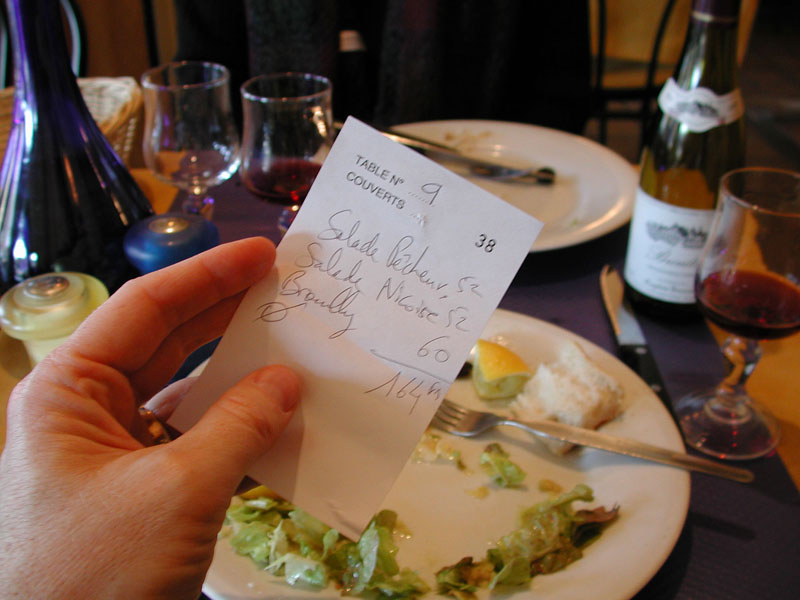Tips on tipping in Europe
This item appears on page 59 of the January 2015 issue.
Here’s a tip. Don’t stress over tipping.
RESTAURANT tips are more modest in Europe than in America. In most places, 10% is a big tip. If your bucks talk at home, muzzle them on your travels. As a matter of principle, if not economy, the local price should prevail. Please believe me: tipping 15% or 20% in Europe is unnecessary, if not culturally ignorant.
Virtually anywhere in Europe, you can do as the Europeans do and (if you’re pleased with the service) add a euro or two for each person in your party.
In very touristy areas, some servers have noticed the American obsession with overtipping… and might hope for a Yankee-size tip. But the good news is that European servers and diners are far more laid back about all this than we are. The stakes are low, and it’s no big deal if you choose the “wrong” amount.
And note that tipping is an issue only at restaurants that have waiters and waitresses. If you order your food at a counter, don’t tip.
At table-service restaurants, the tipping etiquette and procedure vary slightly from country to country, but, in general, European servers are well paid, and tips are considered a small “bonus”… to reward great service or for simplicity in rounding the total bill to a convenient number. In many countries, 5% to 10% is sufficient.
•
In Mediterranean countries, the “service charge” (“servizio” in Italian, “service” in French, “servicio” in Spanish) can be handled in different ways. Sometimes the menu will note that the service is included (“servizio incluso”), meaning that the prices listed on the menu already have this charge built in. When the service is not included (“servizio non incluso”), the service charge might show up as a separate line item at the end of your bill.
In Northern and Eastern Europe, the menu or bill is less likely to address the “service charge,” but you can usually assume that it’s included in the price.
To get the bill, you’ll have to ask for it. Before it comes, make a mental tally of roughly how much your meal should cost. The bill should vaguely resemble the figure you expected. (It should at least have the same number of digits.) Look at your bill carefully; if you have questions, ask your server.
Of course, each country has its own quirks when it comes to tipping. In Germanic countries, it’s considered discreet and classy to say the total number of euros you’d like the waiter to keep (including his tip) when paying. So, if the bill is €41, hand him €50 while saying, “45.” You’ll get €5 back and feel pretty European.
In Prague and most places in the Czech Republic, your bill will state — in English — whether or not service is included. In most cases it’s not, so round up the bill by adding 5% to 10% and paying in cash. Speaking just a few Czech words will get you better service. (If you greet your waiter in English, he’ll want a 15% tip.)
In London many restaurants list a 12.5% “optional” tip on the bill, but you should tip only what you feel the service warrants.
Typically, it’s better to hand the tip to the waiter when you’re paying your bill than to leave it on the table, particularly in busy places where the wrong party might pocket the change. Servers prefer to be tipped in cash even if you pay with your credit card (otherwise, the tip may never reach your server); in many cases, there isn’t even a line on the credit-card receipt for a tip.
•
Americans frequently worry about tipping CABBIES. It’s simple: for a typical cab ride, round up to the next euro on the fare (to pay a 13-euro fare, give €14); for a long ride, round up to the nearest 10 (for a 76-euro fare, give 80 euros). If you feel like you’re being driven in circles or otherwise ripped off, skip the tip.
Tipping for special service is optional. Local GUIDES who give talks at public sights or on bus tours often hold out their hands for tips after they give their spiel. If I’ve already paid for the tour or admission to the sight, I don’t tip extra (but if you want to tip, a euro or two is enough).
In general, if someone in the SERVICE INDUSTRY does a super job for you, a tip of a couple of euros is appropriate… but not required.
When in doubt, ask. The French and British generally tip HAIRDRESSERS; the Dutch and Swedish usually don’t.
If you’re not sure whether (or how much) to tip for a service, ask your hotelier or the tourist information office. They’ll fill you in on how it’s done on their turf.
Rick Steves writes European travel guidebooks and hosts travel shows on public television and public radio. Reach him at Rick Steves’ Europe, Inc., 130 Fourth Ave. N., Edmonds, WA 98020-3114; phone 425/771-8303, www.ricksteves.com.


